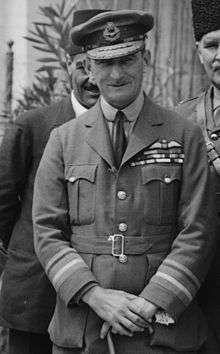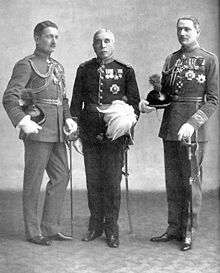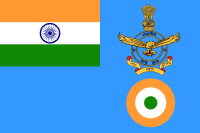Geoffrey Salmond
Air Chief Marshal Sir William Geoffrey Hanson Salmond, KCB, KCMG, DSO (19 August 1878 – 27 April 1933) was a senior commander in the Royal Flying Corps during the First World War. Remaining in the Royal Air Force after the war, he held senior appointments in the Middle East, Great Britain and India. In 1933, Salmond served as Chief of the Air Staff for only a matter of days before being taken ill and subsequently dying from cancer.
Sir Geoffrey Salmond | |
|---|---|
 Air Vice Marshal Sir Geoffrey Salmond in 1920 | |
| Birth name | William Geoffrey Hanson Salmond |
| Born | 19 August 1878 Hougham, Kent, England |
| Died | 27 April 1933 (aged 54) King Edward VII Hospital for Officers, St. Marylebone, London, England |
| Allegiance | United Kingdom |
| Service/ | British Army (1898–18) Royal Air Force (1918–33) |
| Years of service | 1898–1933 |
| Rank | Air Chief Marshal |
| Commands held | Chief of the Air Staff (1933) Air Defence of Great Britain (1931–33) RAF India (1926–31) Air Member for Supply and Research (1922–26) RAF Middle East Area (1917–22) Palestine Brigade RFC (1917) Middle East Brigade RFC (1916–17) 5th Wing RFC (1915–16) No. 1 Squadron RFC (1915) |
| Battles/wars | Second Boer War First World War |
| Awards | Knight Commander of the Order of the Bath Knight Commander of the Order of St Michael and St George Distinguished Service Order Mentioned in Despatches (7) Order of Saint Stanislaus, 3rd Class (Russia) Grand Officer of the Order of the Nile (Egypt) Grand Commander of the Order of the Redeemer (Greece) |
Early life
Geoffrey Salmond was born the son of Major General Sir William Salmond and Emma Mary Salmond (née Hoyle).[1] His siblings included a brother, John,[1] and a sister Gwen.[2][3] He was educated at Wellington College in Berkshire before joining the Army.[1]
Royal Artillery service
Salmond joined the British Army, undertaking his officer training at Royal Military Academy Woolwich around 1897.[4] He was commissioned into the Royal Artillery on 23 June 1898[5] and saw active service during the Second Boer War.[4] He took part in the relief of Ladysmith and the operations on the Tugela Heights.[6] He received he Queen's Medal and seven clasps, then on 10 November 1900 he was sent to China[7] and gained a medal for the operations during the Boxer Rebellion there.[6] He was seconded to study Japanese on 2 May 1905[8] and promoted to captain on 2 December 1905.[9] He was then appointed Adjutant with the Royal Field Artillery on 4 February 1908.[10] Then in 1911 he attended the Staff College, Camberley.[4]
Royal Flying Corps service
Salmond was awarded Royal Aero Club Aviator's Certificate no. 421 on 18 February 1913,[11] and then joined the reserve of the Royal Flying Corps on 17 April 1913.[12] He became a staff office at the War Office on 31 July 1913,[13] a staff officer in the Directorate of Military Aeronautics on 31 August 1913 and then a staff officer at Headquarters Royal Flying Corps in France on 4 August 1914.[14]
Salmond went on to take up the post of Officer Commanding No. 1 Squadron RFC on 26 January 1915.[15] In the First World War the squadron operated over the Western Front and Salmond and his squadron took part in the Battle of Neuve Chapelle, including the Battle of Hill 60 and the Battle of Aubers Ridge.[4] He was appointed a wing commander on 18 August 1915[16] and sent to command the Fifth Wing in Egypt in November 1916.[4] He was promoted to brevet lieutenant colonel on 3 June 1916.[17]
In July 1916, Salmond was promoted to temporary brigadier general and given command of the RFC in the Middle East.[4] The Distinguished Service Order was conferred on him on 3 March 1917:[18]
for conspicuous ability and devotion to duty when personally directing the work of the Royal Flying Corps during the action. The striking success attained was largely due to his magnificent personal example.
The action referred to was during the operations in Sinai at the end of 1916.[1] In this command he was responsible for providing air cooperation for General Jan Smuts's force in East Africa,[6] for the forces in Salonika and Mesopotamia, for Allenby's conquest of Palestine, and for the RFC in India.[6] He was promoted to the substantive rank of lieutenant colonel on 3 September 1918.[19]
While holding the command of the Middle East, he had laid out an airway from Cairo to South Africa,[1] clearing a chain of aerodromes in Central Africa. His idea was to send a demonstration flight or flights of RAF aircraft across Africa, thus providing the link of which Cecil Rhodes had dreamed in a Cape-to-Cairo railway.[6] Salmond contemplated flights by both landplane and flying-boat. He was not destined to put his idea into execution, though his airway was used by Sir Pierre van Ryneveld and Sir Sir Christopher Brand on their first flight to South Africa.[6] He was appointed a Grand Officer of the Egyptian Order of the Nile on 9 November 1918,[20] a Companion of the Order of the Bath in the 1919 New Year Honours,[21] and a Grand Commander of the Greek Order of the Redeemer on 5 April 1919.[22] He was appointed a Knight Commander of the Order of St Michael and St George on 3 June 1919 and mentioned in despatches on account of his services in the Middle East on 28 June 1919.[23]
Royal Air Force service

Salmond was awarded a permanent commission in the Royal Air Force as a major general in August 1919 (shortly afterwards redesignated as an air vice marshal).[24] On 23 February 1922 Salmond returned to Great Britain to take up the post of Director-General of Supply and Research at the Air Ministry.[25] The following year, his post was renamed Air Member for Supply and Research and he remained as the head of Supply and Research for the RAF until late 1926.[4] He was advanced to Knight Commander of the Order of the Bath in the 1926 Birthday Honours.[4]
Salmond's next appointment was as Air Officer Commanding India in December 1926.[4] He travelled to India by aircraft, making him the first officer to travel to an overseas command by air. He was promoted to air marshal on 1 July 1929.[26] In September 1931, Salmond returned from India to take up command of the Air Defence of Great Britain organization which was responsible for British air defences, including both fighters and bombers.[4] He was promoted to air chief marshal several months later on 1 January 1933.[27]
On 1 April 1933, Air Chief Marshal Salmond took over from his brother John as Chief of the Air Staff.[28] At this stage he was already suffering from incurable cancer although it is unclear whether Salmond or his brother knew this at the time. Days later (5 April) arrangements were announced for Sir John Salmond to resume the RAF's senior post temporarily. However, Geoffrey Salmond never recovered and he died on 27 April 1933. Sir John Salmond resumed his duties as Chief of the Air Staff for several more weeks after Sir Geoffrey Salmond's death.[4]
Family
In 1910 he married Margaret Carr, daughter of William Carr; they had a son and three daughters.[1] His daughter Anne wrote a biography of Salmond, published in 2003.[29]
References
- "Sir Geoffrey Salmond". Oxford Dictionary of National Biography. Retrieved 5 August 2012.
- Irish Art Auction. Archived 21 August 2014 at the Wayback Machine Whytes. Retrieved 20 August 2014.
- Obituary Mary H. Hoyle Salmond. Retrieved 20 August 2014.
- "Air Chief Marshal Sir Geoffrey Salmond". Air of Authority – A History of RAF Organisation. Retrieved 5 August 2012.
- "No. 26983". The London Gazette. 1 July 1898. p. 3985.
- "Obituary: Sir Geoffrey Salmond Air Chief Marshal And Chief Of The Air Staff". London: The Times. 28 April 1933. p. 19. Retrieved 5 August 2012.
- "No. 27248". The London Gazette. 20 November 1900. p. 7137.
- "No. 27798". The London Gazette. 26 May 1905. p. 3769.
- "No. 27875". The London Gazette. 16 January 1906. p. 383.
- "No. 28111". The London Gazette. 21 February 1908. p. 1206.
- "Aviators' Certificates". Flight International. 1913. Retrieved 5 August 2012.
- "No. 28720". The London Gazette. 20 May 1913. p. 3592.
- "No. 28747". The London Gazette. 19 August 1913. p. 5932.
- "No. 28879". The London Gazette. 25 August 1914. p. 6686.
- "No. 29055". The London Gazette. 2 February 1915. p. 1018.
- "No. 29276". The London Gazette. 24 August 1915. p. 8520.
- "No. 29608". The London Gazette (Supplement). 2 June 1916. p. 5565.
- "No. 29968". The London Gazette (Supplement). 2 March 1917. p. 2190.
- "No. 31160". The London Gazette (Supplement). 31 January 1919. p. 1760.
- "No. 31002". The London Gazette (Supplement). 8 November 1918. p. 13274.
- "No. 31098". The London Gazette (Supplement). 31 December 1918. p. 91.
- "No. 31273". The London Gazette (Supplement). 4 April 1919. p. 4513.
- "No. 31498". The London Gazette (Supplement). 8 August 1919. p. 10195.
- "No. 31486". The London Gazette. 1 August 1919. p. 9864.
- "No. 32635". The London Gazette. 10 March 1922. p. 2048.
- "No. 33513". The London Gazette. 2 July 1929. p. 4365.
- "No. 33898". The London Gazette (Supplement). 30 December 1932. p. 16.
- "No. 33926". The London Gazette. 31 March 1933. p. 2194.
- "Happy 100th for Anne", Salisbury Journal, 21 May 2014. Retrieved 10 August 2014
Further reading
| Wikimedia Commons has media related to Geoffrey Salmond. |
- Baker, Anne (2003). From Biplane to Spitfire: the life of Air Chief Marshal Sir Geoffrey Salmond KCB KCMG DSO. Pen & Sword Ltd. ISBN 0-85052-980-8.
- Probert, Henry (1991). High Commanders of the Royal Air Force. HMSO. ISBN 0-11-772635-4.
| Military offices | ||
|---|---|---|
| Preceded by Charles Longcroft |
Officer Commanding No. 1 Squadron RFC January – August 1915 |
Succeeded by Philip Joubert de la Ferté |
| Preceded by Unknown |
Officer Commanding Fifth Wing, RFC 1915–1916 | |
| New title Middle East Brigade established |
General Officer Commanding Middle East Brigade Post upgraded to GOC HQ RFC Middle East from October 1917 1916–1917 |
Succeeded by Sefton Brancker |
| New title Palestine Brigade established |
Officer Commanding Palestine Brigade October – November 1917 | |
| Preceded by Sefton Brancker |
General Officer Commanding HQ RFC Middle East From 1 April 1918 GOC RAF Middle East Area From 18 March 1920 AOC Middle East Area 1917–1922 |
Succeeded by Edward Ellington |
| Preceded by Sir Edward Ellington |
RAF Director-General of Supply and Research Post renamed Air Member for Supply and Research in 1923 1922–1926 |
Succeeded by Sir John Higgins |
| Air Officer Commanding RAF India 1926–1931 |
Succeeded by Sir John Steel | |
| Commander-in-Chief Air Defence of Great Britain 1931–1933 |
Succeeded by Sir Robert Brooke-Popham | |
| Preceded by Sir John Salmond |
Chief of the Air Staff 1933 |
Succeeded by Sir John Salmond |
